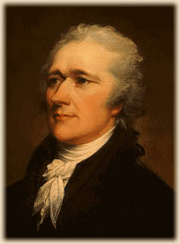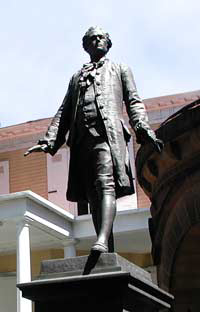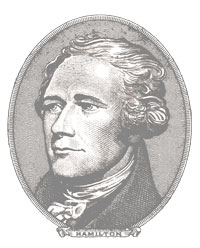
 |
 |
|
|
BACKGROUND | THREE GREAT REPORTS | THE CORPORATE EXAMPLE | THE DUEL
Alexander Hamilton THREE GREAT REPORTS: Portrait of Alexander Hamilton by John Trumbull (c. 1806) An amazing career carried Hamilton from obscure beginnings on the island of Nevis to a distinguished position in American public life. By 1789 he had already won high reputation as a spokesman in the Revolutionary debate, as General Washington's trusted military advisor, as an influential promoter of the Constitutional Convention, and as co-author of the Federalist papers. In 1782, shortly after leaving the army, he was admitted to legal practice in New York City and became recognized as one of the leading lawyers in the country. Hamilton then became the guiding genius of the administration of George Washington. He was a mere 32 years old when he assumed his post as the nation's first Secretary of the Treasury. Much of the first president's administration dealt with establishing effective operating procedures in the new and complex political system of checks and balances among the separate branches of government. President Washington also turned to Hamilton to provide answers concerning public policy. The "Federalism" of Hamilton centered much on the need for a central authority strong and firm enough to "provide for the common defense" and promote the national interest of the United States in its relations with external powers. A burdensome public debt (the price of independence), an uncertain tax revenue, a shortage of capital, and a depreciated currency left the country in a perilous position. To place the new government on firm ground, it was necessary to find economic remedies. Hamilton advanced the broad use of federal powers to strengthen social-economic opportunity for individuals and to stimulate and direct the economic development of the country. He proposed a systematic policy for the Congress to follow based on a bold conception of the role of central government in establishing public credit and promoting economic development. Agriculture, commerce, industry and finance would be integrated in an expanding national economy. This was a design for prosperity with a design for national power. Hamilton prepared three great reports to Congress that defined the major policies of Washington's administration. These reports formed a coherent plan for America's finances. The plan was to fortify America's credit by settling its debts and using that credit to allow manufacturers to develop. This, in turn, would create a diverse and flourishing economy, which would then generate revenue that ensured the debt's proper funding. Underlying the specific measures was a broad conception of the relation between government and the economy. A poor and stagnant economic society could not sustain a strong and secure nation. A flimsy government could not maintain the property rights or promote the welfare of its citizens. In Hamilton's view, a great nation, sound public finance and a highly developed commercial economy were interdependent objects. To accomplish such objectives a firm central government would have to take command. Report on Credit: The first report, the "Report on Public Credit," was presented to the House on January 14, 1790. America's credit could only be established by resolving the problem of its outstanding debts. These debts were I.O.U.s given to soldiers during the Revolutionary War, which were being traded at 20 to 25 percent of their face value, and wartime debts owed by the states. Failure to meet the interest payments or provide for the retirement of the debt had shaken the faith of public creditors. Hamilton proposed that the national government assume the war debts of the states and suggested a schedule for paying off the I.O.U.s by exchanging the depreciated certificates at face value for long-term, interest-paying government bonds. Import duties and internal excise taxes would provide the means for meeting interest charges. A sinking fund would be formed to retire the bonds as they matured. He understood that regular payments of America's debt would bolster its credit. Confidence in the solvency and good faith of the government would raise property values and stimulate business activity. In addition, the funded debt, in the form of negotiable government bonds, would serve the holders as capital to finance new enterprises. He knew that government securities could act as capital for a cash-starved economy. His system was designed to channel the talents and resources of men in trade and commerce into productive activities that served the public interest. In sum, Hamilton proposed to strengthen the federal government and promote national prosperity by setting the public finances in order. James Madison of the House of Representatives opposed Hamilton's plan for the federal government to take on, or assume, the accumulated debts of the states. He saw this plan as unfair to the southern states, including Virginia, that had already paid off most of their wartime debts. He also saw it as the federal government seizing greater power over the economies of the states. He and Secretary of State Thomas Jefferson thought that the federal economic policy should be to get out of the way to allow the natural laws of economic recovery and growth to proceed. However, Hamilton saw his plan as a way to consolidate the states debts and nationalize the economy for the benefit of all. He knew that North America contained vast resources of natural riches that offered prospects of great prosperity if economic development was advanced and managed by his proposed policies on the national level. Hamilton's plan did not make passage in Congress until a deal was struck to pass the plan in exchange for moving the nation's capital from New York City to a more central location along the Potomac River. This was favored by the Virginians and especially by President Washington who lived on the Potomac. Virginia was also looking for a more favorable settlement of its wartime accounts, which Hamilton satisfied by reducing its total obligation. Eventually, four congressmen, all of them from districts bordering on the Potomac, changed their votes for "assumption." Since the Potomac location was an uninhabited swamp at that time, Hamilton agreed to make Philadelphia the interim site for ten years, soothing Pennsylvania's desire to be the capital's site. This "Compromise of 1790" was finally realized at a dinner party at Jefferson's lodgings at 75 Maiden Lane in New York City. Both Madison and Hamilton attended. This compromise was Hamilton's politicking at his best. Although he admitted that the price he paid was high by trading away the New York location, he overwhelmingly confirmed his primary commitment to the country's economic advancement. A political crisis that threatened the survival of the new republic was averted. Opinion on the Constitutionality of the Bank: Establishment of the first Bank of the United States with branches spread over the Union continued Hamilton's basic program. The Bank would increase the capital available to the business community, support the value of government bonds, provide a source of public loans, facilitate the collection and disbursement of government funds and quicken the general circulation of money. Hamilton's report was delivered in December of 1790, calling for a bank with a capital of $10 Million. He recited for Congress the advantages of a national bank: it could multiply its hard currency reserves by making loans and could provide a source of loans to the government in case of emergencies, such as war. President Washington, uncertain of the congressional power to charter a banking corporation, requested a legal opinion from Hamilton concerning this. Hamilton's "Opinion on the Constitutionality of the Bank" persuaded Washington to sign the bank bill. The Bank of the United States was chartered in 1791. Again, political strength and economic growth would advance together under the guidance of national policy. Report on Manufacturers: On Jan. 15, 1790, the House of Representatives had directed Hamilton to prepare a plan to make the United States "independent of other nations…. for military supplies." As a Federalist, Hamilton believed that the American government should be directly involved in an effort to transform the largely agrarian society into a country with both agriculture and industrialization. He saw this move as the only way America could guarantee its freedom from dependence on Europe. This view was the opposite of that held by Thomas Jefferson and others, who favored an agrarian economy. In the "Report on Manufactures" he submitted to Congress, Hamilton provided his vision for American manufacturing. He listed seven ways manufacturing added to society, instead of merely diverting useful effort from agriculture:
By a system of protective tariffs and other encouragements, he hoped to create a diversified national economy in which factory and farm, town and country, would exchange a growing number of commodities. The wealth of the nation would increase with the development of mechanized industry and the fuller employment of the labor force. Diverse economic interests would develop in different parts of the country and would create a continental market economy. In addition, national security would be served by providing a domestic source of strategic manufactures. Although Hamilton's recommendations for a broad range of tariffs and bounties to stimulate the growth of manufacturing were not adopted, the "Report on Manufacturers" was Hamilton's most ambitious report and had lasting importance. It was a passionate analysis of economic diversity that echoes throughout history. As the poet William Carlos Williams wrote, "(Y)ou wanted to organize the country so that we should all / stick together and make a little money." Collectively, Hamilton's financial programs succeeded in restoring public credit and stimulating economic development. It united men of commerce and finance and many others behind the national government. Hamilton returned to New York City and public life at the beginning of 1795, after his 38 th birthday. The state of public affairs allowed him to retire. American finances were in good order: by this time, the United State had the highest credit rating in Europe of any nation, some of its bonds selling at 10 percent over par (in other words, investors were paying premiums to hold them). Hamilton became a national hero. Prosperity was so widespread that for the first time in memory nearly everybody except the tobacco planters was able to get out from under debt to Europe. Fresh capital was pouring in from abroad and, together with the paper capital created by Hamilton’s system, it fueled an unprecedented burst of developmental energy. In New York, the excess of money triggered a mania for getting rich quickly, but elsewhere the money was translated into tangible improvements. Forty corporations - as many as had been chartered in the colonial and Confederation periods combined—were chartered by state legislatures in 1791—92, nine of them for banks, the remainder for manufacturing and for canals, turnpike roads, and water works. Farmers, too, were faring well, and not just because they were getting good prices for their products. Before the Hamiltonian system was enacted, Massachusetts and Virginia had been levying a million dollars a year in direct taxes on land, Connecticut more than $200,000, Pennsylvania $600,000. Almost all these taxes were for servicing public debts, since the "civil lists" or regular expenditures in each state were nominal. After Hamilton’s system was adopted, these tax burdens disappeared, and in most places ordinary landowners became as free from taxation, except for modest local needs, as in the halcyon days before 1763. Washington, on his tour through the South in 1791, made a point of sounding out the popular mood, especially in areas that had opposed ratification of the Constitution, and learned that the people "appeared to be happy, contented and satisfied" with the national government.
BACKGROUND | THREE GREAT REPORTS | THE CORPORATE EXAMPLE | THE DUEL |



